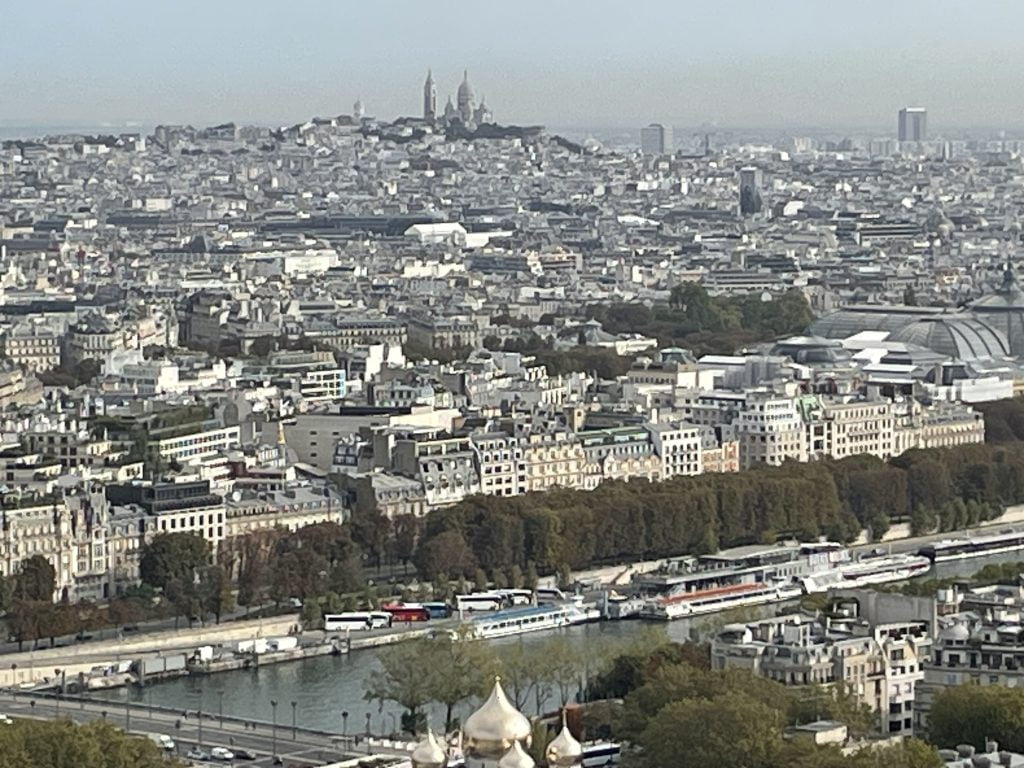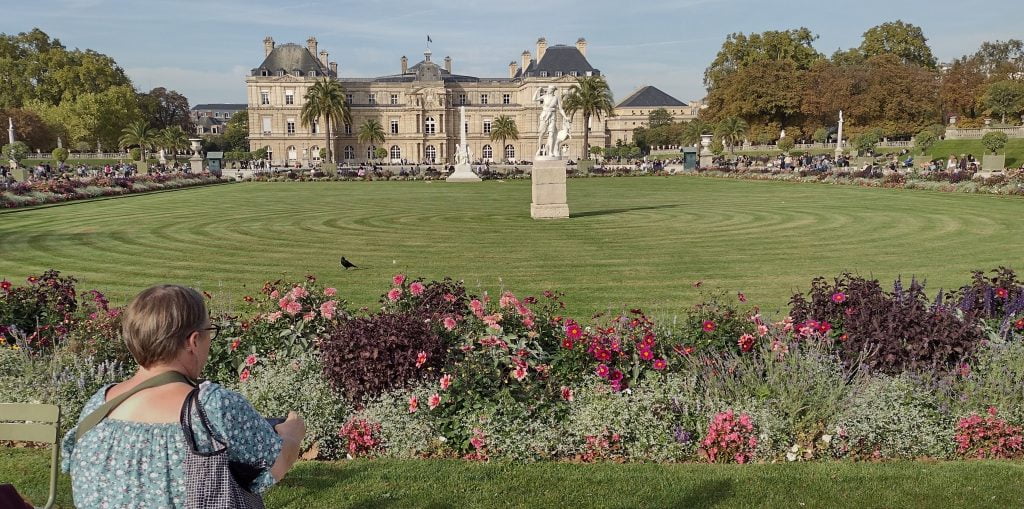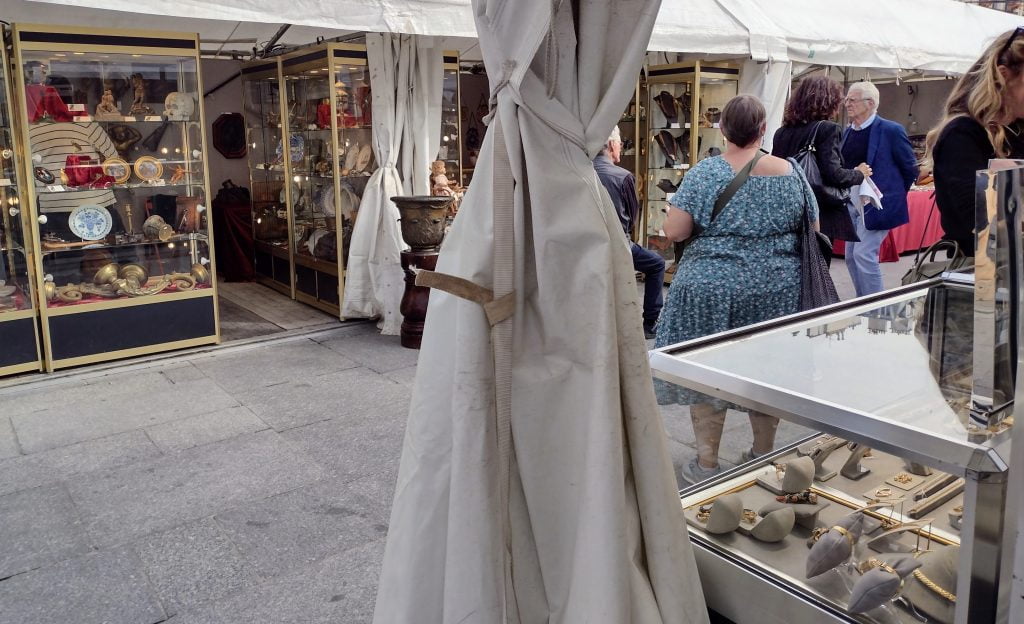This is what we did today:

Stef here: I kind of almost didn’t want to go to the Eiffel Tower. When I was making plans January through August, I definitely wanted to go. Then I got to Europe and did a bunch of the touristy things. They were exhausting, kind of dehumanizing, and so, so overwhelming. The online advice I had read was that the Eiffel Tower was absolutely the most intensely touristy of all the touristy things you could do, and I was kind of scared. So there was part of me that thought we should maybe take the loss on our non-refundable tickets, and do something – anything – else.
In the end, we got up early (by vacation standards), got around on the train, and really from the moment we were in sight, I was caught up in the gleeful giddiness of it. The actual Eiffel Tower. It is certainly towering.

It was built for completely no practical purpose, but just to be impressive, and beautiful, and a testament to the ability of men (and they were all men) to build things with their hands. It is a stunning example of the contemporary style which we might call “steampunk” today. It succeeds wildly at every one of its goals.

And you know what? Even the touristy parts of it were just not that bad. We’d bought timed tickets, so the lines weren’t that long, and the people weren’t so bad, and everywhere we wanted to jockey for a view, we got exactly that view with only a little patience. But I get ahead of myself.
You can take the stairs to the lower levels for free, or you can take elevators up to a second platform, or a topmost platform, as your vacation budget allows. As a spry young thing, Daniel had dashed up the stairs to the lower platform in 1999, but he was with me, so my lazy butt was taking the elevator. We took an angled elevator past the first platform and up to the second.
The Eiffel Tower was made by the French who brought you the Statue of Liberty, in an era that saw a lot of these iron-built public works, so there’s something so tangible and real-life about the scale of these things. They are massive, they are intended to impress you, but you can practically see the people gripping the tools that drove the rivets – there is something human-made about the Eiffel Tower that is missing from the glass and steel towers I see in cities today. The elevator showed this off beautifully.
We didn’t spend a lot of time on the second platform at this point, because we were going higher still, but we saw enough to know that we wanted to see more, and this was going to be very, very cool.
Like I said, I made these plans months ago, so I’m not sure what possessed me to insist that we go all the way to the top given the horror stories I’d heard about the lines, but indeed we had tickets up to the top, so up we went.
From the very top, Daniel described it as a flattening effect – and for sure, you’re so high above everything, it does look very small and two-dimensional. What’s neat is that this is the only vantage point we’d been anywhere in Paris where you can actually see the end of the city; it’s an absolutely massive area, and from the top of the tower, you can finally see the buildings turn into farmlands at the horizon.

It was a cloudy day with the sun emerging at intervals, so we chased the light around the tower to catch things that stood out the most when struck by a sunbeam. Case in point: Sacre Coeur, the Montmartre basilica we’d enjoyed so much yesterday.

We took the elevator back down to the second platform, and could in many ways get a better look at some of the monuments and important buildings we’d barely been able to identify from above. Here, we could pick out the Galleries Lafayette and Church of Saint Marie Madeleine and the Tuileries Gardens and Musee D’Orsay and more still.

We hit the gift shop (which impressed me with its reasonably small markups), and decided to take the stairs the rest of the way down. This afforded us still more great looks at the construction of the thing, and it was fun to imagine 20-something dudes hanging off the sides to drive rivets and taking baguette breaks on the steel girders. I’d read a fun work of historical fiction called Paris: The Novel, and large sections were devoted to a character employed as one of the builders of the tower, so it was easy to imagine the construction as a lively time.
Overall, I have to say, I am intensely glad we did not let our fears drive us away from the Eiffel Tower. The crowds were not that bad, the people were easier to deal with than they’d been in a lot of places, and the whole operation was pretty well organized. But most of all, the sheer fascinating Parisianness of it was just beautiful to behold, and felt…important. We got up close and personal with what might be the world’s most iconic symbol of a city, a city we have loved and enjoyed and been so glad to see. I wouldn’t have missed it for the world.
The Champs de Mars park runs from the river way up the other side of the Tower, and we spent a small amount of time there. But we were pretty hungry and tired, so we mostly made a beeline for lunch. We found a good Italian place in a happy shopping district near the park, and ate all the bread and pasta we desired.

We strolled through the neighborhood with its upscale apartments and shops and dogs…

…in search of a street called Rue Cler, which I had heard was neat. I didn’t know what it would be exactly. Imagine my delight when it turned out to be a whole gorgeous pedestrian corridor dedicated to all things related to glorious French cuisine.



There were incredible produce stalls, and classy meat vendors, fancy takeaway counters, and so, so many little shops. We hardly knew what to buy first, but were very pleased to pick up some Lebanese takeaway for an al fresco dinner later.

Thrilled with this little street, we headed for our next destination, Luxembourg Gardens. Our way to the metro took us by the very end of the Champs de Mars park, so we loved getting a look at the Eiffel Tower that had so much more texture to us now:

The Luxembourg Gardens was a fabulous place.

There were a ton of zones that suited what different uses people would have for a park. There were more natural areas for relaxing and connecting with trees.

There were manicured gardens of dahlias, and probably lots of roses, but too late in the year for those.

There were tables for playing games.

There was a carousel with a ring game, and a puppet theater for the kiddoes.

This small spot where Paris has authorized people to lie on the grass, which is a rare treat among big city parks.

And big stately fountains befitting the palace grounds this used to be, before everyone could enjoy this piece of the city.

It’s been so wonderful seeing these European parks, and it makes us appreciate our many and beautiful Portland parks even more. This spot reminded Dan of North Portland’s Peninsula Park sunken garden area.

We were headed to the Pantheon, and on our way, saw Saint Sulpice, a massive cathedral built all Napoleonic style:

The scale of the thing was staggering, but no photos inside, so we didn’t stay long.
We came across the most surprising open-air market we’d seen so far – it was in tents like a lot of the community markets we’d seen, but there were glass jewelry counters set up like these were permanent installations. We couldn’t make heads or tails of the thing. It was neat to see, but we were clearly not their target clientele. It was mostly glassware and quirky antiques pieces like the stoneware skull in the back of this photo.

We approached the Pantheon to the sounds of someone on a P.A. system – was there some kind of demonstration taking place? Was there a protest? It turned out to be a neighborhood block party, with a hype man on the mic and a D.J. firing up the crowd (well, there was no crowd, but there were happy people milling around).
The Pantheon itself is a grand monument to great men and women of French history. Only about 80 people have been placed there in a politicized process called “pantheonization” that reflects the priorities of the time: Catholicism, war, industry, science, culture. It’s awesome to see such a breadth of people celebrated in such a large scale. But also it was late, we were tired, and the ticket was pretty spendy to go inside, so we opted to admire the outside, but I’m sure it’s well worth seeing. Next time.

Right behind the Pantheon, we saw this library:

We weren’t sure exactly, but the signs seemed to instruct that people with library cards were welcome, but visitors needed a ticket obtained in advance, which certainly wasn’t us. We’re pretty sure they didn’t want tourists bumbling around taking photos, so we moved on.
To this! An absolutely beautiful church, this one dedicated to Sainte Genevieve, and elegant like you’d want a lady saint’s church to be. We snapped one photo, then saw that they had a sign up requesting no visitors during services – which was exactly what was happening there. We sheepishly made our way out, but were glad we saw what we did.


We popped out of the church, bopped along a few blocks, then crested a hill to find ourselves squarely in our now-familiar neighborhood! The trees at the bottom are the Sorbonne buildings across the street from our home here.

Much like the experience we’d had in Amsterdam, we were so pleased to see how much richness is available in a tiny radius around our lodgings. It’s a little sad to find all this out the day before our last day, but better late than never.
Speaking of awesome things in our neighborhood, we took our Lebanese takeaway to the Roman amphitheater Daniel had found, and watched the kids playing football and the elders playing petanque and the college kids playing some other game until the security guard came at dusk to kick everyone out.
On our way home, we saw some great color in the sky.

We are thrilled to have tomorrow to mostly stay close and relish the Latin Quarter.

Another terrific day. Paris is endlessly intriguing.